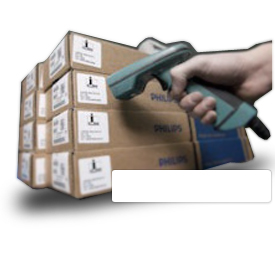RFID - Radio Frequency Identification Labels
 Gun reading RFID Labels
Gun reading RFID Labels
Radio frequency identification, or RFID, is a generic term for technologies that use radio waves to automatically identify people or objects. There are several methods of identification, but the most common is to store a serial number that identifies a person or object, and perhaps other information, on a microchip that is attached to an antenna (the chip and the antenna together are called an RFID transponder or an RFID tag). The antenna enables the chip to transmit the identification information to a reader. The reader converts the radio waves reflected back from the RFID tag into digital information that can then be passed on to computers that can make use of it.
 Transponders (chips) are available in many sizes and capacities for a variety of applications.
Transponders (chips) are available in many sizes and capacities for a variety of applications.
An RFID system consists of a tag, which is made up of a microchip with an antenna, and an interrogator or reader with an antenna. The reader sends out electromagnetic waves. The tag antenna is tuned to receive these waves. A passive RFID tag draws power from field created by the reader and uses it to power the microchip's circuits. The chip then modulates the waves that the tag sends back to the reader and the reader converts the new waves into digital data for use in the application.
Microchips in RFID tags can be read-write or read-only. With read-write chips, you can add information to the tag or write over existing information when the tag is within range of a reader, or interrogator. Read-write tags usually have a serial number that can't be written over. Additional blocks of data can be used to store additional information about the items the tag is attached to. Some read-only microchips have information stored on them during the manufacturing process. The information on such chips can never been changed. Other tags can have a serial number written to it once and then that information can't be overwritten later.
For more information about our RFID labels and applications, please Contact Us.
